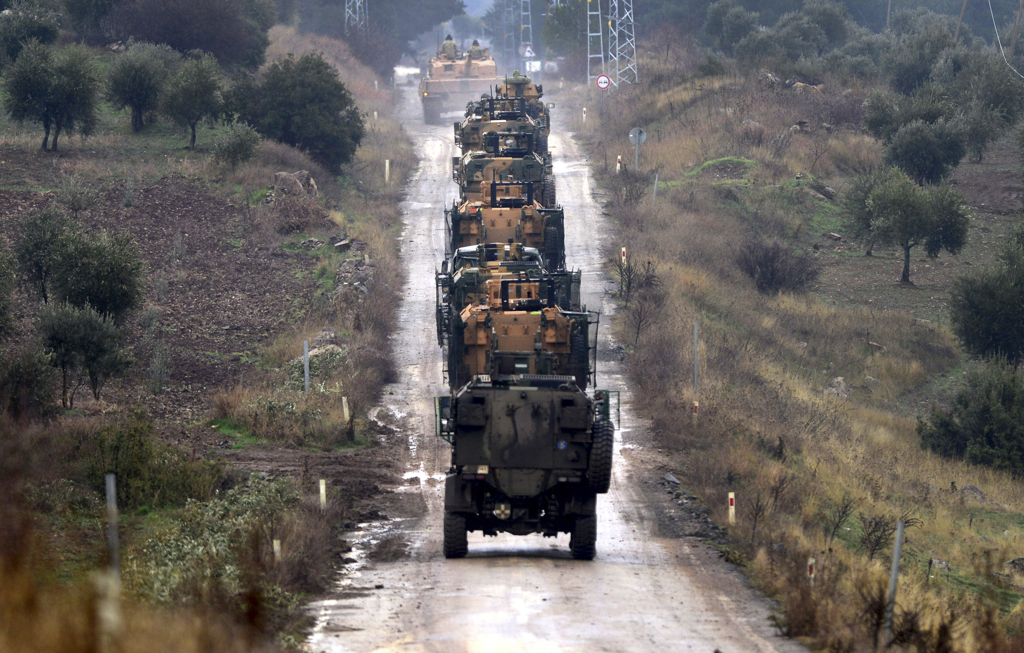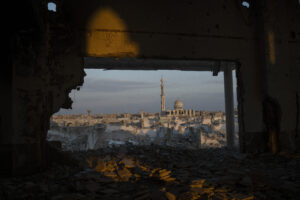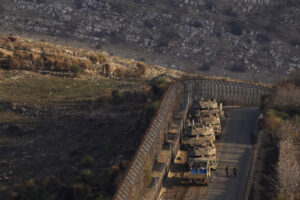America’s Syria Trap
Once again, the United States is in the middle of a byzantine quagmire in the Middle East that could get worse. A convoy of Turkish Army armoured personnel carriers led by a tank are driven toward the border with Syria, in the outskirts of Hassa, Turkey, Tuesday, Jan. 23, 2018. Turkey's Foreign Minister Mevlut Cavusoglu has announced that a second Turkish soldier has been killed in action in Turkey's military offensive on a Kurdish-held enclave in northern Syria. (Ibrahim Mase/DHA-Depo Photos via AP)
A convoy of Turkish Army armoured personnel carriers led by a tank are driven toward the border with Syria, in the outskirts of Hassa, Turkey, Tuesday, Jan. 23, 2018. Turkey's Foreign Minister Mevlut Cavusoglu has announced that a second Turkish soldier has been killed in action in Turkey's military offensive on a Kurdish-held enclave in northern Syria. (Ibrahim Mase/DHA-Depo Photos via AP)
Remember when a ground invasion of a sovereign country—perpetrated by a NATO ally—would constitute a big story?
Before Donald Trump, “Russiagate” and the mainstream media’s apparent obligation to cover every presidential tweet, Turkish planes bombing—and tanks rumbling through—Syria might’ve been real news. These days hardly anyone has the energy to care. No, Washington pols have been too busy misappropriating the poor, underpaid military to bolster their own narrative around the three-day government shutdown. Neither side comes up for air long enough to ask real questions about the mission and status of all those American soldiers and Marines still deployed in Syria—not all that far from the Turkish military incursion.
Hate to say I told you so, but I saw the Turkish invasion coming, all but predicted it, in fact. Heck, anyone paying just a little attention could have. Thing is, most Americans—for all their thanks-for-your-service platitudes—couldn’t give a hoot about foreign policy. There’s no draft, no new taxes, they’ve got no “skin in the game.” Well, as the monumental catastrophe that is the Syrian civil war escalates with the latest Turkish invasion, someone ought to remind Americans that they’ve still got a few thousand troops on the ground there.
The whole situation is a mess, and once again it appears the U.S. military is caught in the middle of the maelstrom. Here’s a one-minute review: Syrian President Bashar Assad, assisted by his Iranian and Russian allies, has all but crushed the rebels west of the Euphrates River. The U.S. and its Saudi Arabian allies are none too happy about that, but they are basically powerless to do anything about it. Islamic State—at least in a conventional sense—has been routed by U.S.-allied Kurdish militias east of the Euphrates. These days, a tense stasis between U.S. and Russian-backed forces exists along the river, just waiting for some spark to kick off a truly catastrophic conflict. Enter the Turks—frenemies and NATO allies to boot—who hate American-sponsored Kurdish militias in Syria’s north. Turkey makes no distinction between the Syrian People’s Protection Units, or YPG (our Kurds), and the insurgent Kurdistan Workers’ Party (PKK) on the other side of the border. The Turks insist they’re both “terrorists”—a convenient label even if it has been so stretched as to elude any real meaning.
So here we are, the American military, staring down the Russians and Assad while holding a weak hand. Nonetheless, senior administration officials and top generals pronounce their intention to indefinitely stay in Syria to “counter Iran” and deny Islamic State’s return.
Haven’t we been here before? I distinctly remember being told my troops had to remain in Iraq and Afghanistan or the “terrorists” would find that mythical “safe haven” in Baghdad or Kandahar. That approach may not be accurate, but it sure is a proven formula for perpetual war. Don’t be surprised when extended U.S. military presence in eastern Syria starts to resemble occupation and a new anti-American insurgency flares up. Call it ISIS 2.0.
The crazy part is, right now, that might be the least of our problems. Turkish planes, troops and armed proxies are rolling toward the town of Manbij, where U.S. troops allegedly are embedded with the YPG. Whether it’s in Manbij or elsewhere, what happens when a Turkish F-16 fighter—designed in America—drops a bomb that kills a U.S. Green Beret in Syria? War with a NATO ally? The closing of strategic U.S. bases in Turkey? An embarrassing climb-down to defuse regional tensions? None of those options sound too appealing, and de-escalation doesn’t strike me as President Trump’s game.
Should Turkey’s bombing and ground incursion catalyze or exacerbate Syria’s broader ethno-sectarian nightmare, well, that’d suit Islamic State just fine. Count on those remarkably resilient and eminently malleable jihadis to exploit the ensuing chaos to reconstitute in Syria’s Sunni heartland. Islamic State may never again field conventional legions, but a slow-burning and no less horrific insurgency appears conceivable. ISIS and other Islamists have a knack for thriving in war-ravaged locales. Need proof? Check out Yemen, where another U.S.-backed war has only empowered the local al-Qaida franchise. This is counterproductivity. The new American way.
The point is as simple as it is alarming. Once again, Washington has trapped itself in a byzantine Mideast quagmire largely of its own making. Worse still, it’s unclear if the administration’s “adults in the room” have anything resembling a coherent exit strategy from Syria. Who’s asking the tough questions? Is anyone piloting this ship? I, for one, am not so sure.
Pay attention, folks. It’s about to get a lot worse in the Middle East. Again. But hey, Americans do love sequels.
The views expressed in this article are those of the author, expressed in an unofficial capacity, and do not reflect the official policy or position of the Department of the Army, Department of Defense or the U.S. government.
Your support is crucial...As we navigate an uncertain 2025, with a new administration questioning press freedoms, the risks are clear: our ability to report freely is under threat.
Your tax-deductible donation enables us to dig deeper, delivering fearless investigative reporting and analysis that exposes the reality beneath the headlines — without compromise.
Now is the time to take action. Stand with our courageous journalists. Donate today to protect a free press, uphold democracy and uncover the stories that need to be told.






You need to be a supporter to comment.
There are currently no responses to this article.
Be the first to respond.